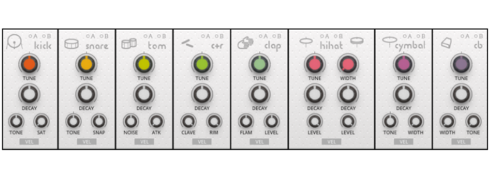

Here, you’ll note that the Sine Oscillator module has two inputs, P and A, and one output, simply named Out.Īssuming you turned on the ‘Show Info Hints’ option, you can get information about how to use the inputs and outputs of a given module properly by hovering over them with the mouse. In Reaktor, each module can have inputs and outputs that can be connected to other modules (Inputs appear on the left hand side of the module, outputs on the right). Let’s start by adding a sine wave: Built-In Module -> Oscillator -> Sine. To add a module in a Reaktor structure, simply right click, choose the proper menu, and then pick a module to add. You should now see the structure of the Instrument: We can also navigate to the structure view of the project by double clicking on any empty area in the beige box marked “Instrument”. The navigator at the top of the picture can be used to quickly traverse between the panel and the structure of the ensemble. This is the front panel of your Reaktor instrument, empty since nothing has been added to it yet. Now that those are set, you should have a project that looks like this:

If you haven’t turned on Wire Debugging, you can do so by pressing CTRL + B, this option will allow you to hover over any Reaktor wire and see the value of that signal.įurther, I would suggest turning on the ‘Show Side Pane’ option, as it will give you easy access to many parameters, and the ‘Show Info Hints’ button, which will provide you with a lot of helpful information while programming.Īll of these options can be found at the top of the Reaktor Interface: First off, make sure the ‘Edit Mode’ box is on.

Since the Reaktor environment is often used simply to open projects created by others, a few options should be switched on before you start building your own projects. If you haven’t already, open Reaktor and create a new ensemble. With that in mind, let’s put together an extremely quick oscillator macro in Reaktor. These waveforms make up the sound sources of most synthesizers, while the other modules we’ll discuss today shape the sound of the oscillators in various ways. The most common types are sine wave, triangle wave, sawtooth and square waves (also called pulse waves). This first How To Build A Synth In Reaktor tutorial assumes that the reader has not built anything in Reaktor yet.īy necessity, I’m going to cover a lot of very basic building stuff to start out, so bear with me, I’ll pick up the pace as soon as possible! OSCILLATORSįirst, we’re going to build a very basic Oscillator macro.Īn OSCILLATOR is a basic piece of any synthesizer that makes a waveform that repeats at a given frequency (usually determined by the note pitch of incoming MIDI notes). To start out, let’s quickly cover the basics of each component of a subtractive synth, and make a basic macro for each in Reaktor. We have a lot of ground to cover between now and then so let’s get down to it. However, in future tutorials this project will be expanded into a full-blown synth complete with it’s own customized waveforms and filters, built from the ground up. As such the end product will not be very complex nor will it be very musical – building a good synth is a lot of work! This first tutorial will focus on the very basic aspects of building in Reaktor, and creating the bare bones of a synth structure. No prior use or understanding of the Reaktor environment is assumed, and I will do my best to explain every single aspect of the synth from the ground up.
#Reaktor blocks tutorial series
Welcome! This tutorial is the first of a series that will teach the absolute beginner the basics of building a subtractive synth in Reaktor. The first in a series of tutorials, How To Build A Synth In Reaktor – A beginners guide will teach an absolute beginner the basics of building a subtractive synth in Reaktor.


 0 kommentar(er)
0 kommentar(er)
